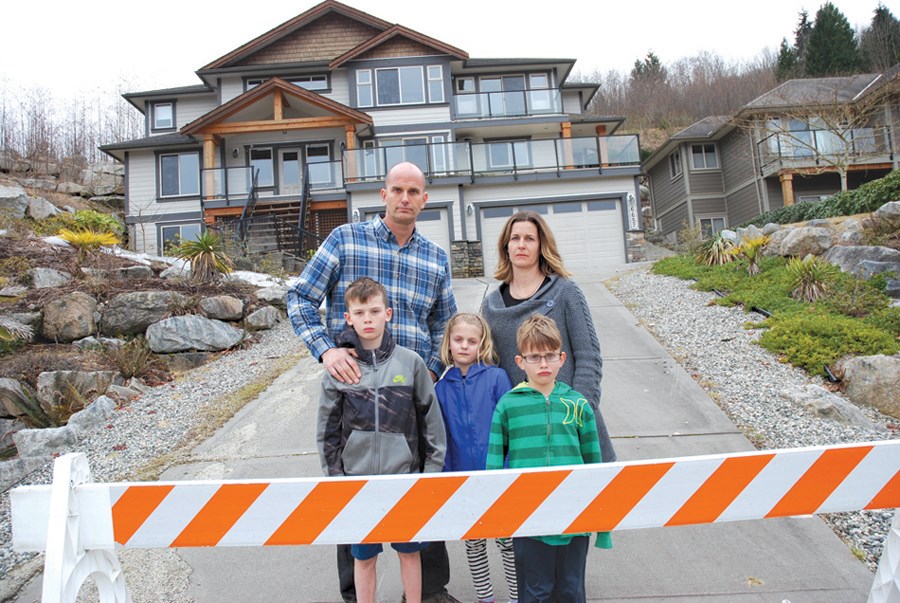It’s been over two years since Ross and Erin Storey and their three children Joffre, Callum and Brynn were forced by the District of Sechelt to leave their home, due to a sinkhole that opened near their front door on North Gale Avenue.
In that time nothing has been done to fix the sinkhole, which has gotten worse; no financial help has been extended to the Storeys, who must continue paying a $1,900 a month mortgage on the uninhabitable home while also paying for a new place to live; and other owners in the area are being cautioned by the district that the same (or worse) could happen to them.
The sinkhole issues in the Seawatch development stretch back to 2012 when the first one swallowed a portion of Seawatch Lane. After that hole was fixed, there was evidence of ongoing underground soil erosion in the area until 2015 when another sinkhole opened outside the Storeys’ front door.
After several geotechnical investigations by the District of Sechelt showed that sinkhole formations were expected to continue in the area, the municipality issued a letter to homeowners last year stating it didn’t plan to undertake any more investigations or invest in any potential fixes, so owners had to decide if they felt comfortable staying in the area.
“As you are aware, past experience has shown that sinkholes can develop in this area with little or no advance warning,” the letter read.
“Accordingly, each of you must give consideration to contacting a geotechnical engineer of your choosing to advise you on this matter and determine whether you wish to continue to occupy your respective residences …”
In an interview this week, Sechelt Mayor Bruce Milne stood by the letter, saying it was necessary to make owners aware of the risk.
“Essentially this is an issue that individuals and private property owners are going to have to make decisions about,” Milne said.
“There is no way to ensure that we could make that [area] safe in a way which was suitable to the municipality, so the individuals were left with a decision that they have to make.”
To date the district has spent over $1 million on engineering reports, Band-Aid solutions and litigation surrounding the Seawatch subdivision sinkholes.
Milne said Sechelt won’t spend much more.
“We need to make sure that the district does what it’s responsible for, accountable for, but not to simply throw taxpayers’ money into a hole in the ground for other people,” he told Coast Reporter.
The estimated cost to fix the underground soil erosion that’s leading to the Seawatch sinkholes is about $9.5 million and it’s still unclear who’s legally responsible to pay for it – the district, developer Ron Antalek of Concordia Seawatch Ltd., or the homeowners themselves as some issues stretch onto private property.
The mayor has encouraged the Storeys and anyone else effected by the sinkholes to sue as a way to enhance “the prospect of reaching a mutually satisfactory omnibus solution” to the problem.
The Storeys did file a lawsuit against Sechelt, as well as a number of other parties who played a part in the building, selling or insuring of their home.
Originally, several other residents in the Seawatch area opened lawsuits too.
“In the beginning I think there was between eight and 10 [lawsuits]. Some have withdrawn since then,” Milne said.
“There’s been some offers of settlement made through Municipal Insurance Agency, but I don’t know the details of any of that.”
The Storeys have a court date set for Oct. 2, 2018 when the judge has given them 100 days in court, in case others want to be heard at the same time, but Erin’s hopeful the entire thing can be dealt with through mediation this year.
That could give the Storeys some financial restitution, and some much needed rest.
Late last year, sensing the saga would not end soon, the Storeys purchased a new home and now they pay two mortgages monthly.
Ross and Erin both work more than 60 hours a week in order to make the payments on their two houses and also pay for their lawyer’s bills.
“It’s been stressful. I feel like we’ve aged 10 years in two,” Erin said.
“We’re strong, though. As stressful as this has been, we’re really trying to compartmentalize this and not let it define us.”
She said apart from her family’s distress in having to leave what was supposed to be their dream home, the saddest part of the last two years has been “what this has done to the [Seawatch] community.”
“We used to be a really tight-knit community and this has just divided the community,” Erin said.
Residents in Seawatch have differing views of how safe the development is and what should or should not be done going forward.



